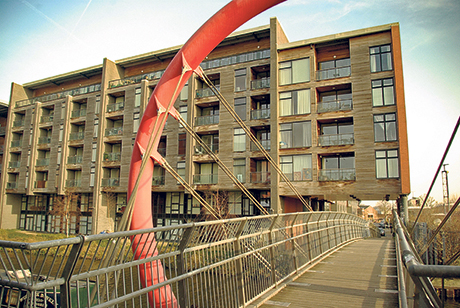Hard to hold a candle to the Wick

Omega Works, Fish Island. Photograph: Antonio Curcetti
Although the revival of Hackney Wick has been in progress for some time now, one can’t help but wonder what its residents of yore would make of the area if they were to walk its streets today. Previously dilapidated warehouses host artisan cafes and galleries, hipsters stumble out of restored factories – all under the shadow of Anish Kapoor’s ArcelorMittal Orbit, and the now iconic Olympic Stadium.
Indeed the Wick, once a major part of London’s industrial landscape, is arguably the city’s most flourishing artistic and cultural hub. Reputed to have more artists’ studios per square mile than any other place in Europe, it offers a unique mixture of utilitarian urban spaces and beautiful nature spots, including Hackney Marshes and the River Lea.
Although it was historically one of the poorest areas in the country, the Wick has an enchanting history. The Matchbox toys were manufactured here, and the first dry-cleaners in England were housed in the Lion Works on Wallis Road.
Far from being the sole preserve of young creatives, the Wick is attracting more and more families. The area is less crowded than the rest of Hackney, and due to its relative isolation is rather quiet. Prices have not yet reached the same heights as surrounding neighbourhoods, so now is the time to make a move.
New developments such as St Mary’s Village, situated just off Eastway, are providing further options, and the Olympic Village flats, now turning into residential properties, will see a whole new addition to the Wick community. Some of the best housing is found on the adjacent Fish Island, but new builds are being planned there, so getting in before the prices spike is advisable.
The boom in local trade as foretold by organisers of the Olympic Games failed to materialise, with most spectators coming into the Olympic Park through the Westfield Stratford mega structure and avoiding the local area altogether. More fool them, as the Wick boasts some of Hackney’s best restaurants and cafes.
The Hackney Pearl on Felstead Street has become a Wick institution, offering a cosy atmosphere, great coffee and seasonal dishes. Another local highlight is the Counter Café in Stour Space on Roach Road – you’ll also find the Carlton and the Hackney Cut nearby.
The Crate Brewery and pizzeria in the White Building in Queen’s Yard has capitalised on the micro-brewery trend, and is often crowded with locals. Go for breakfast to enjoy an ale in peace and quiet. Eastway market, which happens every Sunday, offers an impressive array of stalls and draws in shoppers from all over the London.
Hackney Wick also hosts two annual festivals – the community-led Hackney Wick Festival, and Hackney WickED, which has evolved into a year-long programme of art events.
Studios and galleries are ubiquitous in the Wick, but if you find yourself yearning for a different artistic medium, head to the Yard, a warehouse-turned-theatre just around the corner from the Overground station, which features an increasingly adventurous programme and some very good grub.
There are very few schooling options within Hackney Wick itself, although the Gainsborough Primary School has recently received an improved Ofsted report and there is a local Montessori school near Victoria Park.
Transport links to the Wick are not great either, and this may be one of the reasons it has managed to retain its character and resist the ruinous regeneration that has plagued other areas of Hackney. But you are by no means stranded. The Overground runs a frequent and reliable service and the newly revamped Stratford tube is on the Jubilee and Central lines, as well as on the DLR and national rail services.
The Wick is very much in a development phase, but its community is stronger than ever. The early adopters are sure to reap the highest rewards.
